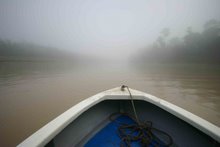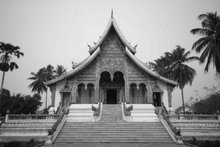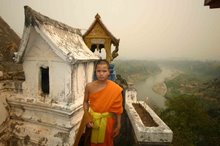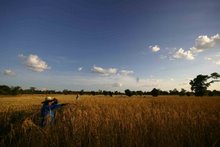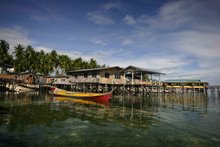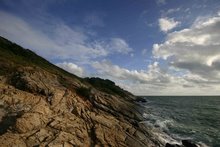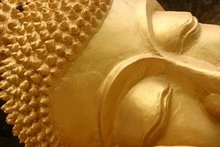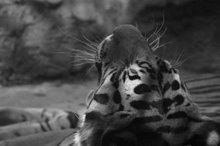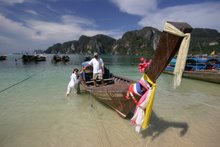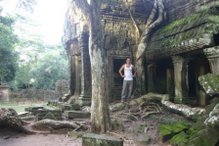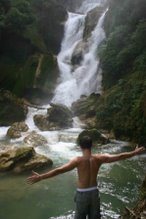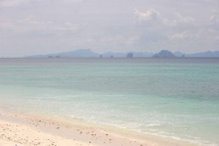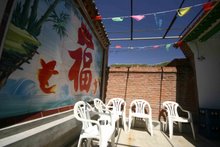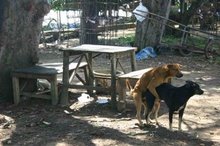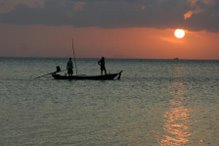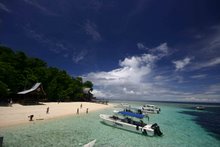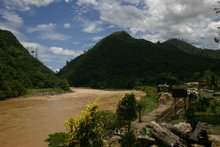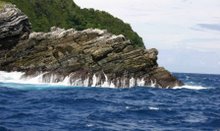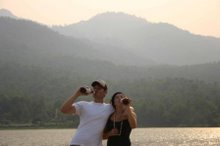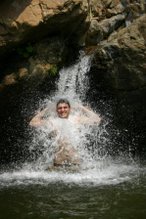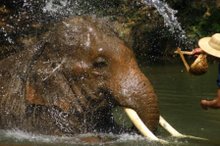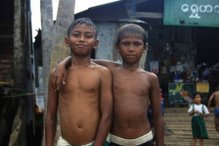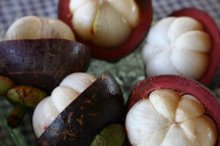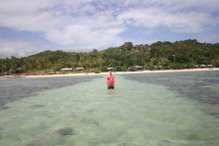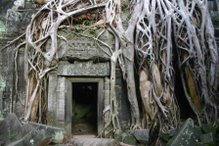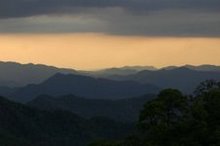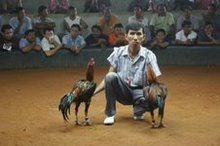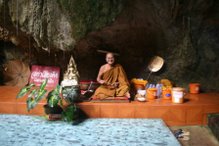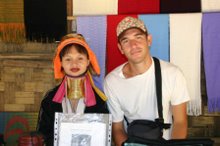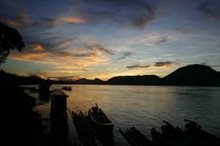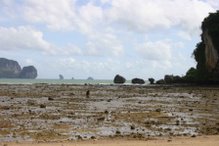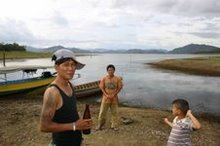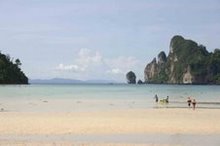 Thanks to the palm oil plantations, the wildlife of Borneo is squeezed to a small area around the Kinabatangan River. While said, this means the high concentration of animals here are great for animal watching of all types. Here are the animals I was able to take decent shots of while living an hour and a half down the river in a camp called, Uncle Tan's.
Thanks to the palm oil plantations, the wildlife of Borneo is squeezed to a small area around the Kinabatangan River. While said, this means the high concentration of animals here are great for animal watching of all types. Here are the animals I was able to take decent shots of while living an hour and a half down the river in a camp called, Uncle Tan's. A heavy fog often layed across the river making it more difficult to spot animals of any kind. At least for me. Lan and the other guides have eagle eyes and could still find wildlife hiding in the mist.
A heavy fog often layed across the river making it more difficult to spot animals of any kind. At least for me. Lan and the other guides have eagle eyes and could still find wildlife hiding in the mist. Here is an example of the boats we cruised down the river in. I initially thought the loud outboard motor and the bright orange life jackets would scare any living thing away before we could get close enough to see it, but for whatever reason, they didn't seem to mind all that much.
Here is an example of the boats we cruised down the river in. I initially thought the loud outboard motor and the bright orange life jackets would scare any living thing away before we could get close enough to see it, but for whatever reason, they didn't seem to mind all that much. Kingfishers are only found where there is water and are a favorite among birdwatchers. Thank god we didn't have any of them on the trip though. We were looking for mammals. Still, these brightly colored birds with large bills and a healthy appetite for fish were pretty cool.
Kingfishers are only found where there is water and are a favorite among birdwatchers. Thank god we didn't have any of them on the trip though. We were looking for mammals. Still, these brightly colored birds with large bills and a healthy appetite for fish were pretty cool. Hornbills are a very common sight on the river. These birds mate for life and are usually seen in couples. Lan told us you could often see them nuzzling their beaks together (all the girls in the boat say: aww...)
Hornbills are a very common sight on the river. These birds mate for life and are usually seen in couples. Lan told us you could often see them nuzzling their beaks together (all the girls in the boat say: aww...) The morning can be a great time to spot crocodiles on the river but with them, the boat motor is a deterrant and it's hard to get close without them slipping off the bank and underneath the water. I would put the visibility of the water at about a quarter of a foot. Whatever's down in there, we couldn't see it. So when a croc dissapeared into the water beneath the boat, we all looked around at each other as if to remind ourselves this wasn't some cheesy horror flick where the deadly croc then knocks over the boat and begins to tear people to bits.
The morning can be a great time to spot crocodiles on the river but with them, the boat motor is a deterrant and it's hard to get close without them slipping off the bank and underneath the water. I would put the visibility of the water at about a quarter of a foot. Whatever's down in there, we couldn't see it. So when a croc dissapeared into the water beneath the boat, we all looked around at each other as if to remind ourselves this wasn't some cheesy horror flick where the deadly croc then knocks over the boat and begins to tear people to bits. The middle of the day can be blazing hot on the river, but usually we spent the time shaded under the tall trees of the rain forest. Away from the banks of the river we went looking for different animals down the numerous trails around camp.
The middle of the day can be blazing hot on the river, but usually we spent the time shaded under the tall trees of the rain forest. Away from the banks of the river we went looking for different animals down the numerous trails around camp. Without even leaving the camp monitor lizards could be seen walking about or digging in the mud for snacks. They weren't shy but would run if we got too close. Along with these guys, wild pigs and long-tailed macacques frequented our camp ground. The pigs were of no worry, but the long-tailed macacques were cheeky monkeys, always getting into anything their could get their hands on. They stole unwatched toast, drank cans of coke and would taste anything that looked remotely like food.
Without even leaving the camp monitor lizards could be seen walking about or digging in the mud for snacks. They weren't shy but would run if we got too close. Along with these guys, wild pigs and long-tailed macacques frequented our camp ground. The pigs were of no worry, but the long-tailed macacques were cheeky monkeys, always getting into anything their could get their hands on. They stole unwatched toast, drank cans of coke and would taste anything that looked remotely like food. These day hikes were not the time to see big animals. Here is the second smallest frog in the entire world. Well, not literally this very frog, but the species is the second smallest. A fact even more useless and obscure than that: it's called the Least Narrow-mouthed Frog. Huh?
These day hikes were not the time to see big animals. Here is the second smallest frog in the entire world. Well, not literally this very frog, but the species is the second smallest. A fact even more useless and obscure than that: it's called the Least Narrow-mouthed Frog. Huh? Okay, so the day hikes weren't crazy-exciting at all. But they could be informative. Here is one of the coolest trees around. It's a murderous tree that grows off of other trees that have already grown tall. It grows so strangely, all over place, because it must suffocate the roots of the host tree in order to take all the nutrients for itself.
Okay, so the day hikes weren't crazy-exciting at all. But they could be informative. Here is one of the coolest trees around. It's a murderous tree that grows off of other trees that have already grown tall. It grows so strangely, all over place, because it must suffocate the roots of the host tree in order to take all the nutrients for itself. Another tree, introduced by Leo The Scorpion Master, this one was of note because of its former use as a perfect tree to make boats. The wood was soft enough for hollowing out to make a canoe and the roots the stand tall from the earth were great for making oars as well. Now this tree is protected from being cut down for any reason.
Another tree, introduced by Leo The Scorpion Master, this one was of note because of its former use as a perfect tree to make boats. The wood was soft enough for hollowing out to make a canoe and the roots the stand tall from the earth were great for making oars as well. Now this tree is protected from being cut down for any reason. After the day hike, the animal watching got more exciting with an late afternoon boat ride where many animals came out to the water before sun down. Here are some of the cheeky long-tailed macacques with a baby.
After the day hike, the animal watching got more exciting with an late afternoon boat ride where many animals came out to the water before sun down. Here are some of the cheeky long-tailed macacques with a baby. I couldn't help myself with this picture. I often felt like I was living the Discovery Channel while I was traveling through Borneo, but this moment here really did it for me, when the two macacques had to answer nature's call and make sweet monkey love right in front of a boat full of cameras. In case you're wondering, monkeys do it doggie-style.
I couldn't help myself with this picture. I often felt like I was living the Discovery Channel while I was traveling through Borneo, but this moment here really did it for me, when the two macacques had to answer nature's call and make sweet monkey love right in front of a boat full of cameras. In case you're wondering, monkeys do it doggie-style.  This could also be a great time to find some crocodiles on the shore, perhaps digesting a big meal. Here, a juvenile makes the scamper for the water after our boat got to near.
This could also be a great time to find some crocodiles on the shore, perhaps digesting a big meal. Here, a juvenile makes the scamper for the water after our boat got to near.  This big boy was not a small croc. When we first spotted it, it was sitting on the bank with its mouth open. It didn't move for a while until we were only meters away. Then it slowly worked its way towards the water, slipped in and it must have gone right underneath our boat. Everyone kept all hands inside the boat.
This big boy was not a small croc. When we first spotted it, it was sitting on the bank with its mouth open. It didn't move for a while until we were only meters away. Then it slowly worked its way towards the water, slipped in and it must have gone right underneath our boat. Everyone kept all hands inside the boat.  Next to the Orang Utan, the most famous animal in Borneo is the proboscis monkey. It is only found in Borneo and is known for the males of the species having such a large nose. Lan was bullshitting about them using it as a snorkel to swim, but internet research has informed me that it's unknown why they have such large noses but is guessed it was to do with sexual selection. Beacuse, you know what they say about monkeys with big noses. Anyways, here's a mother -who has a small nose- carrying a baby.
Next to the Orang Utan, the most famous animal in Borneo is the proboscis monkey. It is only found in Borneo and is known for the males of the species having such a large nose. Lan was bullshitting about them using it as a snorkel to swim, but internet research has informed me that it's unknown why they have such large noses but is guessed it was to do with sexual selection. Beacuse, you know what they say about monkeys with big noses. Anyways, here's a mother -who has a small nose- carrying a baby.  Here's a picture of a male and although I couldn't get a close enough shot to really capture the great size and hilarity of his nose, continuing on the Discovery Channel theme, he's also flashing his red monkey-penis for the camera. Eww.. you just looked, didn't you?
Here's a picture of a male and although I couldn't get a close enough shot to really capture the great size and hilarity of his nose, continuing on the Discovery Channel theme, he's also flashing his red monkey-penis for the camera. Eww.. you just looked, didn't you? Night river safaris can be the most fun on the river since there's potential to see all kinds of nocturnal animals they won't come to the river during the day.
Night river safaris can be the most fun on the river since there's potential to see all kinds of nocturnal animals they won't come to the river during the day. Unfortunatly for us, we just saw more of these damned macacques. Upon first arrival they're really interesting, but by the time you leave the Kinabatangan, they bore you to tears.
Unfortunatly for us, we just saw more of these damned macacques. Upon first arrival they're really interesting, but by the time you leave the Kinabatangan, they bore you to tears.  This common mangrove snake slept in a tree just above the water, supposedly digesting a meal. Making us all love the macacques all the more, while we were just underneath the snake flashing our lights upwards, it began to rain. Then we realized it wasn't raining. All the monkeys in the tree were pissing down on us. Thanks, guys.
This common mangrove snake slept in a tree just above the water, supposedly digesting a meal. Making us all love the macacques all the more, while we were just underneath the snake flashing our lights upwards, it began to rain. Then we realized it wasn't raining. All the monkeys in the tree were pissing down on us. Thanks, guys. Kingfishers are always out on the river, looking to snatch up a fish. Again, I'm not nuts about the birds but this photo turned out pretty good.
Kingfishers are always out on the river, looking to snatch up a fish. Again, I'm not nuts about the birds but this photo turned out pretty good. The most adventerous of our animal watching were the night treks. We all were thick rubber boots to walk through the foot-thick mud in the jungle. Armed with headlamps, we crept into the darkness looking for all the creepy-crawly things you don't want in your bed at night.
The most adventerous of our animal watching were the night treks. We all were thick rubber boots to walk through the foot-thick mud in the jungle. Armed with headlamps, we crept into the darkness looking for all the creepy-crawly things you don't want in your bed at night.  This was a baby tarantula. I wasn't able to get a shot of the momma tarantula, but it was big, hairy, and gross. These things give me the chills. Seeing one up in the trees ups the intensity of the night trek, always wondering if there's one above you that might decide to drop down on your neck.
This was a baby tarantula. I wasn't able to get a shot of the momma tarantula, but it was big, hairy, and gross. These things give me the chills. Seeing one up in the trees ups the intensity of the night trek, always wondering if there's one above you that might decide to drop down on your neck.  This centipede isn't much a harm. Upon touching it, it will curl into a spiral in order to protect itself. Still, watching all of it's tiny legs move like a little wave against the ground and imagining it crawling up your leg can give you the creeps.
This centipede isn't much a harm. Upon touching it, it will curl into a spiral in order to protect itself. Still, watching all of it's tiny legs move like a little wave against the ground and imagining it crawling up your leg can give you the creeps.  Here, Leo, as he promised he would, found a scorpion. This was an active one and it was crawling all over him. Leo was so happy I thought it was just tickling him. This guy loves scorpions. Perhaps a little too much. He's been stung in the neck before (he's also been bit by a tarantula). Even more than this, what's funny is that he told us his goal is to put a scorpion in his mouth. What? I don't know exactly why, but I guess that's how you get a rush when you live in the jungle. And I can already see the line of questions: What happened to your mouth? I was bit by a scorpion. How did it bite you in the lip? Well, you see, I was trying to put it in my mouth...
Here, Leo, as he promised he would, found a scorpion. This was an active one and it was crawling all over him. Leo was so happy I thought it was just tickling him. This guy loves scorpions. Perhaps a little too much. He's been stung in the neck before (he's also been bit by a tarantula). Even more than this, what's funny is that he told us his goal is to put a scorpion in his mouth. What? I don't know exactly why, but I guess that's how you get a rush when you live in the jungle. And I can already see the line of questions: What happened to your mouth? I was bit by a scorpion. How did it bite you in the lip? Well, you see, I was trying to put it in my mouth...  And here is my favorite photo of all, even though it's very dark and it's difficult to see what's going on. Let me fill you in. We came across this monitor lizard sleeping in a tree. That's not all that strange in itself, but just look at this lizard. He looks passed the f out. All his legs are hanging down from the branch and his head is cocked back, his chin resting on the branch. It looks like he got too drunk at a jungle party and passed out in a horribly uncomfortable position.
And here is my favorite photo of all, even though it's very dark and it's difficult to see what's going on. Let me fill you in. We came across this monitor lizard sleeping in a tree. That's not all that strange in itself, but just look at this lizard. He looks passed the f out. All his legs are hanging down from the branch and his head is cocked back, his chin resting on the branch. It looks like he got too drunk at a jungle party and passed out in a horribly uncomfortable position.
 Captured here by the camera of Lisa and Cian O'Fearghail are the tiny creatures that have created a new love of diving in me, totally different from the excitement of seeing sharks, turtles, or barracuda under the water. These are parts of the micro-life of muck diving, tiny inhabitants of corals, anemones, sea fans, sandy bottoms, and other remote habitats on the reef. They are more difficult to find than the large sharks that swim in depths and thus, despite their size, create a big excitement in divers that enjoy looking for them.
Captured here by the camera of Lisa and Cian O'Fearghail are the tiny creatures that have created a new love of diving in me, totally different from the excitement of seeing sharks, turtles, or barracuda under the water. These are parts of the micro-life of muck diving, tiny inhabitants of corals, anemones, sea fans, sandy bottoms, and other remote habitats on the reef. They are more difficult to find than the large sharks that swim in depths and thus, despite their size, create a big excitement in divers that enjoy looking for them. Savvy and local divers like to joke that diving on Sipadan is like watching TV. It's hardly a task to find the sharks and turtles and other large life that swim frequently in its waters. These sea slugs, called nudibranchs, aren't so obvious. These picture here are hardly more than an inch long and although they are brightly colored, they are easily over-looked swimming through a lively coral reef. It takes a keen, experienced (or just lucky) eye to find them. When I first was diving on sites such as Bohayan and Sibuan, DMs and other divers would point these out to me I would look around, all over the reef having no idea what I was even looking for.
Savvy and local divers like to joke that diving on Sipadan is like watching TV. It's hardly a task to find the sharks and turtles and other large life that swim frequently in its waters. These sea slugs, called nudibranchs, aren't so obvious. These picture here are hardly more than an inch long and although they are brightly colored, they are easily over-looked swimming through a lively coral reef. It takes a keen, experienced (or just lucky) eye to find them. When I first was diving on sites such as Bohayan and Sibuan, DMs and other divers would point these out to me I would look around, all over the reef having no idea what I was even looking for. The micro life isn't exclusively nudibranchs. There is a multitude of other tiny, rare animals that live on the reef. Tiny shrimps often play symbiotic roles of cleaning, tiny crabs scutter about the reef too small to look appetizing, and juvenile fish flutter about swimming foolishly with their minuscule fins (a personal being a juvenile harlequin sweetlips, which might be the most clumsy and frantic of all swimmers in the ocean).
The micro life isn't exclusively nudibranchs. There is a multitude of other tiny, rare animals that live on the reef. Tiny shrimps often play symbiotic roles of cleaning, tiny crabs scutter about the reef too small to look appetizing, and juvenile fish flutter about swimming foolishly with their minuscule fins (a personal being a juvenile harlequin sweetlips, which might be the most clumsy and frantic of all swimmers in the ocean). Pictured here is probably the most popular of the micro-life of diving in Semporna: pygmy seahorses. These little things are smaller than your pinky fingernail and they hang about on large sea fans on the reef. They can be terribly difficult to see, let alone photograph, so again I'm amazed Lisa could capture such a fantastic photograph of this one perched on the fan. Pygmy seahorses take care and patience to see. Often there's is a current in the water and to an inexperienced diver, looking extremely close to a large sea fan when there's a strong current could lead to a horrible collision. Also, diving with a number of other people, it's impossible for everyone to take a peek at the same time. Everyone must take turns shoving their mask up close to the seahorses in order to witness them.
Pictured here is probably the most popular of the micro-life of diving in Semporna: pygmy seahorses. These little things are smaller than your pinky fingernail and they hang about on large sea fans on the reef. They can be terribly difficult to see, let alone photograph, so again I'm amazed Lisa could capture such a fantastic photograph of this one perched on the fan. Pygmy seahorses take care and patience to see. Often there's is a current in the water and to an inexperienced diver, looking extremely close to a large sea fan when there's a strong current could lead to a horrible collision. Also, diving with a number of other people, it's impossible for everyone to take a peek at the same time. Everyone must take turns shoving their mask up close to the seahorses in order to witness them.















































